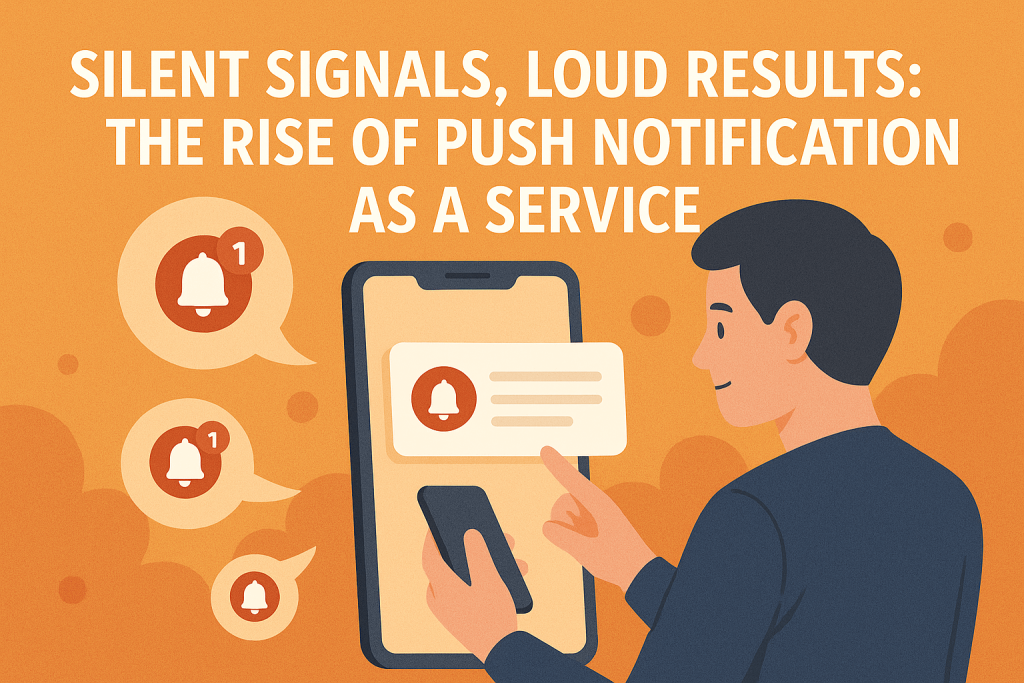In an era where attention is currency, businesses and platforms are constantly searching for faster, smarter, and less intrusive ways to engage with users. Whether you’re a growing startup, a global e-commerce brand, or a content publisher, your ability to communicate with your audience in real time can dramatically impact your performance metrics—especially retention, conversions, and customer satisfaction.
Email, SMS, and in-app messaging have served this purpose for years, but their limitations are increasingly apparent. Emails go unopened, SMS feels invasive, and in-app messages rely on the user already being present. What if you could bypass all that and speak directly to your users—anytime, anywhere, without demanding their attention up front? That’s where push notifications come into play.
With the emergence of push notification as a service, companies no longer need to build the infrastructure themselves to deliver timely, relevant, and personalized notifications across web and mobile platforms. Instead, third-party solutions provide cloud-based delivery systems that simplify everything—from user consent management to segmentation and analytics. These platforms are scalable, secure, and designed to integrate effortlessly into websites, web apps, and mobile applications.
What Is Push Notification as a Service?
Push Notification as a Service (PNaaS) refers to third-party cloud platforms that enable businesses to send real-time alerts and messages to their users without developing a full messaging system internally. These services handle everything: subscriber management, content delivery, scheduling, personalization, and reporting.
These platforms leverage APIs and SDKs (software development kits) to integrate with web and mobile applications. Once integrated, businesses can send notifications about new content, discounts, updates, reminders, abandoned cart alerts, or anything else that may boost user engagement.
The key appeal of push notification as a service is that it removes the technical barrier to entry. Organizations don’t need to manage infrastructure, write low-level code, or worry about delivery protocols. They simply plug in the service, define their messaging strategy, and start communicating with users at scale.
How Does It Work?
The backbone of a push notification system involves four main components:
- Permission Handling – When users visit a website or open an app, they’re asked to opt in to receive notifications.
- Service Workers or Device Tokens – In web environments, browsers create a service worker; on mobile, apps generate a device token.
- Push Server – This server queues and sends out the actual notifications, either through browser services (like Firebase Cloud Messaging) or mobile notification protocols (like Apple Push Notification Service).
- Notification Payload – A message typically includes a title, body text, optional icon or image, and a link or call to action.
Push notification services abstract away the technical complexity. They offer drag-and-drop editors, audience targeting options, automation workflows, and performance dashboards—all accessible through user-friendly dashboards.
Why Businesses Are Adopting Push Notification Services
There are several compelling reasons why companies across industries are integrating these platforms into their marketing and product strategies:
- Fast Time to Market: Setting up in-house infrastructure takes weeks or months. Using a third-party service can take hours or days.
- Cross-Platform Reach: PNaaS platforms support Android, iOS, web, desktop, and even progressive web apps (PWAs).
- Cost Efficiency: Most services operate on a freemium or pay-as-you-grow model, making them accessible even for small businesses.
- Behavioral Targeting: Modern platforms offer segmentation based on user behavior, location, preferences, and engagement history.
- Rich Notifications: Advanced services support images, carousels, action buttons, and deep linking—turning a short message into an interactive experience.
Ultimately, PNaaS empowers even non-technical teams to deliver sophisticated messaging campaigns with minimal effort.
Popular Push Notification as a Service Platforms
Some of the most widely adopted platforms include:
- OneSignal – One of the most popular freemium platforms, offering web and mobile push with robust analytics and segmentation tools.
- Firebase Cloud Messaging (FCM) – Google’s solution, tightly integrated with Android and Chrome. Ideal for developers and enterprise apps.
- Airship (formerly Urban Airship) – Enterprise-grade solution with A/B testing, automation, and deep personalization capabilities.
- Pusher Beams – Tailored for transactional push notifications, commonly used in messaging apps and real-time alerts.
- WonderPush – GDPR-compliant, easy to implement, and well-suited for publishers and e-commerce platforms.
Choosing the right platform depends on your needs: developer control, ease of use, audience size, privacy compliance, and cost.
Use Cases Across Industries
Push notification services are incredibly versatile. Here’s how different industries are using them:
E-commerce
- Notify users of cart abandonment
- Offer flash sales and promo codes
- Restock or delivery updates
Media & Publishing
- Send real-time breaking news
- Share curated content based on interests
- Alert users to live streams or events
SaaS
- Product update announcements
- Onboarding guides and feature tips
- Account usage alerts
Education & Learning
- Course enrollment and deadline reminders
- Live webinar notifications
- Certification updates and class summaries
Each of these use cases focuses on relevance and timing—the two most critical components of engagement.
Privacy, Compliance, and User Trust
With increased regulatory scrutiny (GDPR, CCPA, etc.), platforms offering push notification as a service must comply with stringent data protection laws. Most reputable providers:
- Avoid collecting personal identifiers unless explicitly consented
- Offer easy opt-in and opt-out flows
- Ensure end-to-end encryption of messages
- Allow businesses to manage user preferences and consent logs
Respecting user choice and privacy is not only legally necessary—it also builds trust and long-term retention.
The Future of PNaaS
Push notification as a service is still evolving. We can expect innovations in:
- AI-Powered Automation: Platforms will automatically optimize send times and messages based on user behavior.
- Increased Personalization: Deep integration with CRM and user data for ultra-specific targeting.
- Two-Way Messaging: Interactive notifications that allow users to respond directly without opening the app or site.
- Voice-Enabled Notifications: Especially relevant as smart devices and voice assistants grow.
The tools will get smarter, more predictive, and even more central to how businesses engage their audiences in real time.
Conclusion
The rise of push notification as a service represents a major leap forward in how brands connect with users. It takes the power of real-time, personalized messaging and makes it accessible to organizations of any size—without the need for extensive technical resources.
As digital communication continues to evolve, companies that embrace these tools will gain a competitive edge in engagement, retention, and overall customer experience. For those still relying solely on email and ads, it might be time to start thinking beyond the inbox—and start thinking push.
Cassia Rowley is the mastermind behind advertising at The Bad Pod. She blends creativity with strategy to make sure ads on our site do more than just show up—they spark interest and make connections. Cassia turns simple ad placements into engaging experiences that mesh seamlessly with our content, truly capturing the attention of our audience.


